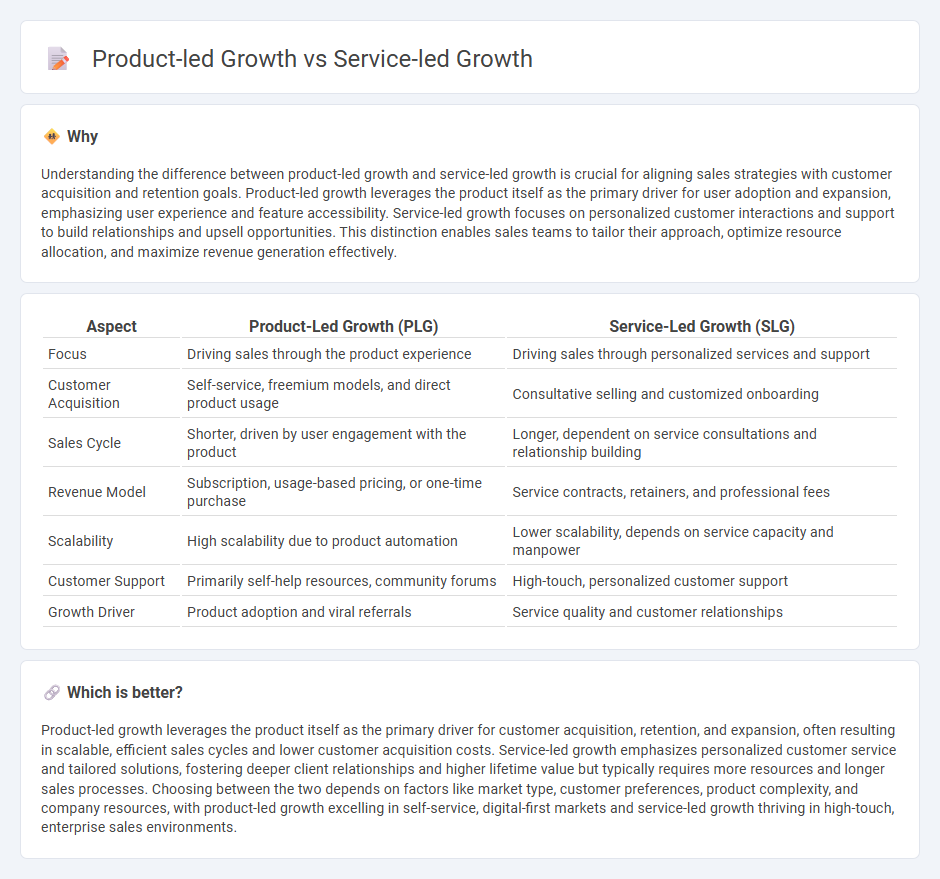
Product-led growth leverages the product itself as the primary driver for customer acquisition, expansion, and retention, focusing on user experience and self-service features to accelerate sales cycles. Service-led growth emphasizes personalized consultations, support, and customized solutions to build strong client relationships and address specific needs. Explore the key differences and benefits of both approaches to optimize your sales strategy.
Why it is important
Understanding the difference between product-led growth and service-led growth is crucial for aligning sales strategies with customer acquisition and retention goals. Product-led growth leverages the product itself as the primary driver for user adoption and expansion, emphasizing user experience and feature accessibility. Service-led growth focuses on personalized customer interactions and support to build relationships and upsell opportunities. This distinction enables sales teams to tailor their approach, optimize resource allocation, and maximize revenue generation effectively.
Comparison Table
| Aspect | Product-Led Growth (PLG) | Service-Led Growth (SLG) |
|---|---|---|
| Focus | Driving sales through the product experience | Driving sales through personalized services and support |
| Customer Acquisition | Self-service, freemium models, and direct product usage | Consultative selling and customized onboarding |
| Sales Cycle | Shorter, driven by user engagement with the product | Longer, dependent on service consultations and relationship building |
| Revenue Model | Subscription, usage-based pricing, or one-time purchase | Service contracts, retainers, and professional fees |
| Scalability | High scalability due to product automation | Lower scalability, depends on service capacity and manpower |
| Customer Support | Primarily self-help resources, community forums | High-touch, personalized customer support |
| Growth Driver | Product adoption and viral referrals | Service quality and customer relationships |
Which is better?
Product-led growth leverages the product itself as the primary driver for customer acquisition, retention, and expansion, often resulting in scalable, efficient sales cycles and lower customer acquisition costs. Service-led growth emphasizes personalized customer service and tailored solutions, fostering deeper client relationships and higher lifetime value but typically requires more resources and longer sales processes. Choosing between the two depends on factors like market type, customer preferences, product complexity, and company resources, with product-led growth excelling in self-service, digital-first markets and service-led growth thriving in high-touch, enterprise sales environments.
Connection
Product-led growth (PLG) and service-led growth (SLG) are connected through their shared focus on customer experience and value delivery, driving revenue expansion. In PLG, the product itself acts as the primary driver for customer acquisition and retention, while SLG emphasizes personalized support and professional services to enhance product adoption and satisfaction. Integrating these approaches leverages product usability with tailored services, optimizing customer lifetime value and accelerating sustainable sales growth.
Key Terms
Customer Success
Service-led growth emphasizes personalized customer success strategies to enhance satisfaction, retention, and long-term value, leveraging tailored support and consultancy. Product-led growth focuses on intuitive product design and self-service capabilities that drive user adoption and engagement through seamless experiences. Explore how integrating both approaches can maximize customer success and business expansion.
User Experience
Service-led growth prioritizes personalized customer interactions and tailored support to enhance user satisfaction, driving brand loyalty and long-term revenue. Product-led growth emphasizes intuitive design and seamless user interfaces, allowing the product itself to attract, engage, and retain customers without heavy reliance on sales teams. Explore detailed strategies to optimize user experience for both growth models and boost your business performance.
Upselling
Service-led growth prioritizes personalized customer interactions to drive upselling by leveraging expert consulting and tailored solutions that enhance client satisfaction and lifetime value. Product-led growth relies on intuitive features and seamless user experiences to encourage organic upselling within the product ecosystem, often using in-app prompts and data-driven insights. Explore the distinct advantages and strategies of each growth model to optimize upselling performance.
Source and External Links
What is Service-Led Growth? I Ibbaka - Service-led growth is a model that creates value by combining services wrapped around a product, delivered via a subscription platform, with data-driven insights to foster ongoing value-based customer conversations and growth through a connected flywheel of services, data, and insights.
An Introduction to Service-Led Growth I Ibbaka - Service-led growth is a hybrid growth model using professional services, software, and data to build deep partnerships and trust between buyers and sellers, ideal for complex solutions delivering profitable and sustainable expansion.
Unlocking the promise of services-led growth - CEPR - Services-led growth is a structural transformation where fast-growing services sectors outpace manufacturing, especially in developing economies, requiring new industrial policies focusing on collaboration, human capital development, and quality job creation.
 dowidth.com
dowidth.com